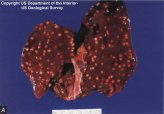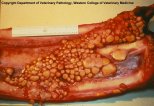|
|
| |
| Causative Agent |
|
Mammals: |
-
Bacterial
disease caused by infection with Mycobacterium bovis,
previously found in domestic cattle, but also known to occur in
specific wildlife populations. In BC, the species of most concern is
wood bison.
|
| Birds: |
-
Bacterial
disease caused by infection with Mycobacterium avium.
|
| Images |
|
Click on images to
enlarge. |
 |
 |
|
Firm nodules within the
liver associated with avian tuberculosis. |
Tuberculosis nodules lying
against ribs within the chest cavity of a
wood
bison |
|
| Distribution |
|
Mammals: |
-
Geographic
-
At present, BC is free of
Mycobacterium bovis.
-
There is a potential for Tb
infection in wild wood bison (Bison
bison athabascae) populations in northeastern BC if
infected bison disperse from Wood Buffalo National Park.
-
Seasonality
-
Infections with M. bovis are
chronic.
|
|
Birds: |
-
Geographic
-
Seasonal trends of tuberculosis in wild birds have not been documented;
infections may occur throughout the year owing to the
chronic nature of this disease.
-
Seasonality
-
In free-ranging wild birds,
avian tuberculosis is found most often in species that
live in close association with domestic stock (house
sparrows [Passer
domesticus] and Eurasian starlings [Sturnus
vulgaris]) and in scavengers (crows and gulls), and
likely exists in small numbers of free-ranging wild
birds wherever there are major bird concentrations.
-
A study in BC found
tuberculosis in 0.6 percent of more than 600 wild birds.
|
|
| Hosts, Transmission and Life
Cycle |
| Mammals: |
-
Hosts
-
Bovine Tb is not a naturally
occurring disease in wild animals and is believed to
have been introduced into wildlife populations through
contact with domestic animals.
-
In Canada, Tb has been
confirmed both in farmed and free-ranging
cervids in some areas, in free ranging wood bison in
Wood Buffalo National Park and in some of the
surrounding bison populations. For more information on
Tb in wild mammals from the Canadian Food Inspection
Agency,
click
here.
-
Carnivores may become
infected with bovine Tb by eating infected carcasses.
-
Life Cycle
-
Survival of Mycobacterium
bovis outside mammalian hosts is variable depending
on ambient environmental conditions (cold, damp
condition increases survival; bright, dry conditions
decreases survival of the
bacteria).
-
Grazing patterns of
different species of wildlife may influence prevalence
of Tb with wild populations. Communally feeding animals
(e.g., elk [Cervus canadensis]) tend to have higher rates of infection than
those who tend to feed alone or in smaller groups (e.g.,
mule deer [Odocoileus
hemionus]). This pattern could affect wildlife
populations should Tb ever become established in wood
bison or other wild
ungulate populations in BC.
-
Transmission
-
Sick animals shed
bacteria through breathing, coughing, or sneezing,
and new hosts are infected when they inhale or ingest
bacteria.
-
Inhalation: infection
establishes itself in the lungs and spreads to the
nearest
lymph nodes.
-
Ingestion: infection
establishes itself in pharynx or small intestine and
spreads to the nearest
lymph nodes.
-
Bacteria are generally destroyed by white blood
cells that the body uses to fight infection; however,
some evade destruction and increase in number. These
large clusters are often visible to the naked eye. They
resemble abscesses and are called “tubercles”.
-
Following infection, an
immune response is mounted by the host; a weak
response allows
bacteria to increase in number producing further
tubercles and lead to localized
necrosis.
-
Clinical signs depend on which organs are affected.
-
With progression,
generalized Tb ensues, leading to weakness, debilitation
and ultimately death or predisposition to predation.
|
|
Birds: |
-
Hosts
-
All bird species are
susceptible to avian Tb.
-
Common in captive birds
(poultry, quail, pigeons, raptors, waterfowl).
-
Humans, livestock, and other
mammals can become infected with M. avium.
-
Life Cycle
-
In free-ranging wild birds,
avian tuberculosis is found most often in species that
live in close association with domestic livestock (house
sparrows [Passer
domesticus] and Eurasian starlings [Sturnus
vulgaris]) and in scavengers (crows and gulls).
-
Transmission
-
Avian Tb generally is
transmitted by direct contact with infected birds,
ingestion of contaminated feed and water, or contact
with a contaminated environment. Inhalation of the
bacteria can cause respiratory tract infections.
|
|
| Signs and Symptoms |
| Mammals: |
-
Some animals may show signs of disease within 6 months of infection while
others may survive for several years without showing signs.
-
Severely infected animals may appear normal if
lesions are confined to internal
lymph nodes or restricted areas of the
lung.
-
Abscesses often develop and may
discharge
pus through skin or
mucosal surfaces.
-
Lesions may mineralize with age and
become visible on x-rays.
-
General symptoms include
weakness, loss of appetite, weight loss, and fluctuating fever.
-
Lesions in wood bison have been
found in the respiratory tract and associated
lymph nodes.
-
Tb
lesions may be found in any organ
or body cavity; early in disease onset,
lesions may be difficult to find
while in the latter stages,
nodules or lumps may be found in
lungs and in
lymph nodes associated with lungs, head
or intestinal tract.
-
A Tb-infected animal may
have multiple tan or yellow lumps on the inside of the ribcage.
Lungs may contain pea-sized tan or yellow lumps or
lesions typical of the disease.
|
| Birds: |
-
Infected birds are often emaciated, weak, and
lethargic, and they exhibit wasting
of the muscles. Other symptoms depend on which body system is
affected and may include diarrhea, lameness, and unthrifty
appearance.
-
The location of
lesions indicates the route of
infection: intestinal
lesions suggest contaminated feed
or water;
lesions in the lung suggest
inhalation.
-
Infected birds often have
solid-to-soft or crumbly, yellow to-white or grey
nodules that are deeply embedded in
infected organs and tissues, < 1 mm to several cm in size. The liver
most often contains such
nodules, but the spleen, lung, and
intestines may also contain similar
nodules. Clusters of these
nodules may appear as firm, fleshy,
grape-like clusters.
Abscesses and
nodule-like growths have been
reported around the eyes, at the wing joints, on the legs, side of
the face, and base of the beak. Some infected birds have died
without any obvious
clinical signs or external
lesions.
-
Infected birds often have
enlarged livers and spleens.
|
| Meat Edible? |
| For Both Mammals and Birds: |
-
Tb
bacteria are very rarely found in
meat (muscle tissue).
-
As a precaution, however,
all meats, including hunter-harvested deer, should be thoroughly
cooked to an internal temperature of 74 ºC (165 ºF) to kill
bacteria.
-
If the lungs, ribcage or
internal organs from wild
ungulates look abnormal (multiple tan
or yellow lumps),
THe meat should
not be eaten and the nearest Health Authority contacted
(see contact list).
-
It is unlikely that a person
field-dressing or eating meat of an animal infected with bovine Tb
could become infected. Nonetheless, hunters should practice sanitary
precautions, including washing after field-dressing an animal.
-
Hunters that suspect their
kill of being infected SHOULD NOT EAT
THE MEAT and should contact their provincial or federal
agencies
(see contact list).
-
Dogs and cats should not be
allowed to roam freely where they could feed on carcasses or gut
piles of infected deer.
|
| Human Health Concerns and
Risk Reduction |
| Bovine Tb: |
-
Human infection occurs either via the respiratory route or through cuts
or abrasions in the skin after being in close contact with infected
animals.
-
Bovine Tb is one of the most infectious forms of Tb and is reportable
under the Health of Animals Act.
-
M. bovis in the environment can be killed easily by a weak
solution of common household bleach (mix 1 part bleach to 9 parts of
water) or other commercial disinfectants. They are also quite heat
sensitive.
|
| Avian Tb: |
-
There are many authenticated cases of M. avium infection in
people, although humans are considered highly resistant to this
organism. Avian Tb is generally considered non-contagious and so it is unlikely that
an infected person could transmit M. avium to an uninfected
person. Infection is more likely to occur in persons with
pre-existent diseases, especially those involving the lungs, and in
persons whose
immune systems are impaired by other
illnesses.
|
| Samples for Diagnosis |
-
Post-mortem
investigation and microscopic analysis of
lesions by
a veterinary pathologist is required.
-
Definitive diagnosis is accomplished by culturing and identifying
the
bacteria.
-
For
birds, if carcasses or tissues cannot be submitted to a laboratory
within a short time, tissues may be preserved in 10 % buffered
formalin solution. The whole carcass of a bird is preferred;
however, if this is not possible, remove the leg at the hip joint,
wrap it in clean aluminum foil, place it in a plastic bag, and
freeze it for shipment to a qualified
disease diagnostic laboratory.
-
Bovine tuberculosis is a
reportable disease in Canada, and under the Health of Animals Act, all cases must
be reported to the Canadian Food Inspection Agency (CFIA).
|
| Similar Diseases |
| Birds: |
|
|
| |
| Further Reading |
-
Canadian Food Inspection Agency – Bovine Tuberculosis
-
Clifton-Hadley, R.S., Sauter-Louis C.M., Lugton I.W., Jackson R., Durr
P.A., Wilesmith J.W.. 2001. Mycobacterial diseases: Mycobacterium
bovis infections. Pp. 340-371 in E.S. Williams, I.K. Barker
(eds.), Infectious Diseases of
Wild Mammals. 3rd Ed. Iowa State University Press. Ames, IA.
-
Friend M. 2001. Tuberculosis. Pp. 93-98 in
Field Manual of Wildlife
Diseases: General Field Procedures and Diseases of Birds. M.
Friend, J.C. Franson (Tech. eds.), E.A. Ciganovich (ed.). Biological
Resources Division Information and Technology Report 1999-001. U.S.
Department of the Interior and U.S. Geological Survey. Washington,
DC. (Chapter
in PDF format)
|
|
|




